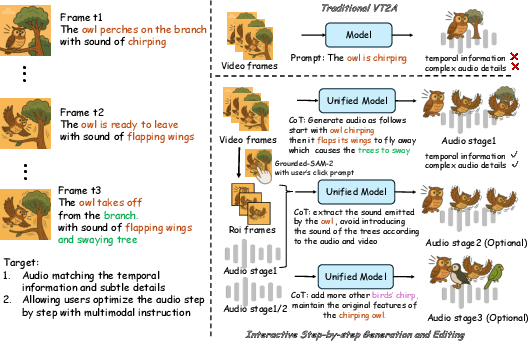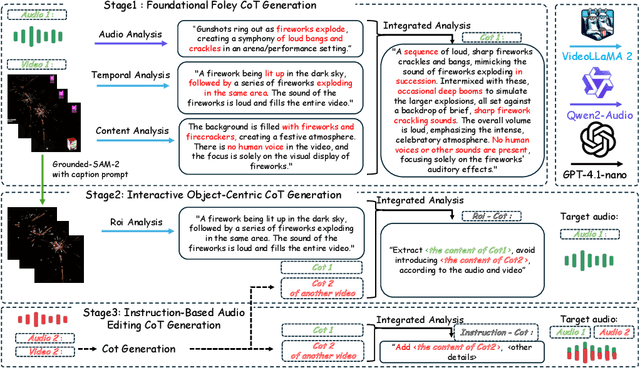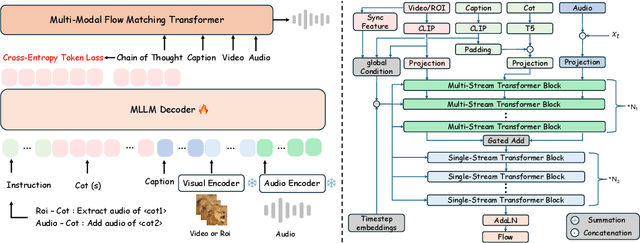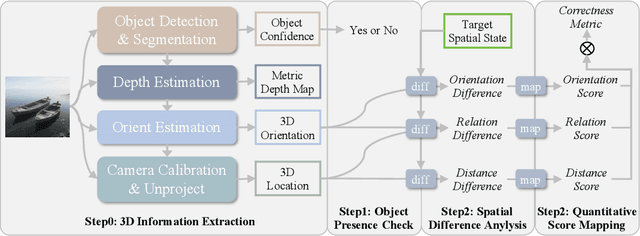Zhou Zhao
Generative Reasoning Recommendation via LLMs
Oct 23, 2025Abstract:Despite their remarkable reasoning capabilities across diverse domains, large language models (LLMs) face fundamental challenges in natively functioning as generative reasoning recommendation models (GRRMs), where the intrinsic modeling gap between textual semantics and collaborative filtering signals, combined with the sparsity and stochasticity of user feedback, presents significant obstacles. This work explores how to build GRRMs by adapting pre-trained LLMs, which achieves a unified understanding-reasoning-prediction manner for recommendation tasks. We propose GREAM, an end-to-end framework that integrates three components: (i) Collaborative-Semantic Alignment, which fuses heterogeneous textual evidence to construct semantically consistent, discrete item indices and auxiliary alignment tasks that ground linguistic representations in interaction semantics; (ii) Reasoning Curriculum Activation, which builds a synthetic dataset with explicit Chain-of-Thought supervision and a curriculum that progresses through behavioral evidence extraction, latent preference modeling, intent inference, recommendation formulation, and denoised sequence rewriting; and (iii) Sparse-Regularized Group Policy Optimization (SRPO), which stabilizes post-training via Residual-Sensitive Verifiable Reward and Bonus-Calibrated Group Advantage Estimation, enabling end-to-end optimization under verifiable signals despite sparse successes. GREAM natively supports two complementary inference modes: Direct Sequence Recommendation for high-throughput, low-latency deployment, and Sequential Reasoning Recommendation that first emits an interpretable reasoning chain for causal transparency. Experiments on three datasets demonstrate consistent gains over strong baselines, providing a practical path toward verifiable-RL-driven LLM recommenders.
DSI-Bench: A Benchmark for Dynamic Spatial Intelligence
Oct 21, 2025Abstract:Reasoning about dynamic spatial relationships is essential, as both observers and objects often move simultaneously. Although vision-language models (VLMs) and visual expertise models excel in 2D tasks and static scenarios, their ability to fully understand dynamic 3D scenarios remains limited. We introduce Dynamic Spatial Intelligence and propose DSI-Bench, a benchmark with nearly 1,000 dynamic videos and over 1,700 manually annotated questions covering nine decoupled motion patterns of observers and objects. Spatially and temporally symmetric designs reduce biases and enable systematic evaluation of models' reasoning about self-motion and object motion. Our evaluation of 14 VLMs and expert models reveals key limitations: models often conflate observer and object motion, exhibit semantic biases, and fail to accurately infer relative relationships in dynamic scenarios. Our DSI-Bench provides valuable findings and insights about the future development of general and expertise models with dynamic spatial intelligence.
SSGaussian: Semantic-Aware and Structure-Preserving 3D Style Transfer
Sep 04, 2025Abstract:Recent advancements in neural representations, such as Neural Radiance Fields and 3D Gaussian Splatting, have increased interest in applying style transfer to 3D scenes. While existing methods can transfer style patterns onto 3D-consistent neural representations, they struggle to effectively extract and transfer high-level style semantics from the reference style image. Additionally, the stylized results often lack structural clarity and separation, making it difficult to distinguish between different instances or objects within the 3D scene. To address these limitations, we propose a novel 3D style transfer pipeline that effectively integrates prior knowledge from pretrained 2D diffusion models. Our pipeline consists of two key stages: First, we leverage diffusion priors to generate stylized renderings of key viewpoints. Then, we transfer the stylized key views onto the 3D representation. This process incorporates two innovative designs. The first is cross-view style alignment, which inserts cross-view attention into the last upsampling block of the UNet, allowing feature interactions across multiple key views. This ensures that the diffusion model generates stylized key views that maintain both style fidelity and instance-level consistency. The second is instance-level style transfer, which effectively leverages instance-level consistency across stylized key views and transfers it onto the 3D representation. This results in a more structured, visually coherent, and artistically enriched stylization. Extensive qualitative and quantitative experiments demonstrate that our 3D style transfer pipeline significantly outperforms state-of-the-art methods across a wide range of scenes, from forward-facing to challenging 360-degree environments. Visit our project page https://jm-xu.github.io/SSGaussian for immersive visualization.
OS Agents: A Survey on MLLM-based Agents for General Computing Devices Use
Aug 06, 2025Abstract:The dream to create AI assistants as capable and versatile as the fictional J.A.R.V.I.S from Iron Man has long captivated imaginations. With the evolution of (multi-modal) large language models ((M)LLMs), this dream is closer to reality, as (M)LLM-based Agents using computing devices (e.g., computers and mobile phones) by operating within the environments and interfaces (e.g., Graphical User Interface (GUI)) provided by operating systems (OS) to automate tasks have significantly advanced. This paper presents a comprehensive survey of these advanced agents, designated as OS Agents. We begin by elucidating the fundamentals of OS Agents, exploring their key components including the environment, observation space, and action space, and outlining essential capabilities such as understanding, planning, and grounding. We then examine methodologies for constructing OS Agents, focusing on domain-specific foundation models and agent frameworks. A detailed review of evaluation protocols and benchmarks highlights how OS Agents are assessed across diverse tasks. Finally, we discuss current challenges and identify promising directions for future research, including safety and privacy, personalization and self-evolution. This survey aims to consolidate the state of OS Agents research, providing insights to guide both academic inquiry and industrial development. An open-source GitHub repository is maintained as a dynamic resource to foster further innovation in this field. We present a 9-page version of our work, accepted by ACL 2025, to provide a concise overview to the domain.
EC-Diff: Fast and High-Quality Edge-Cloud Collaborative Inference for Diffusion Models
Jul 16, 2025Abstract:Diffusion Models have shown remarkable proficiency in image and video synthesis. As model size and latency increase limit user experience, hybrid edge-cloud collaborative framework was recently proposed to realize fast inference and high-quality generation, where the cloud model initiates high-quality semantic planning and the edge model expedites later-stage refinement. However, excessive cloud denoising prolongs inference time, while insufficient steps cause semantic ambiguity, leading to inconsistency in edge model output. To address these challenges, we propose EC-Diff that accelerates cloud inference through gradient-based noise estimation while identifying the optimal point for cloud-edge handoff to maintain generation quality. Specifically, we design a K-step noise approximation strategy to reduce cloud inference frequency by using noise gradients between steps and applying cloud inference periodically to adjust errors. Then we design a two-stage greedy search algorithm to efficiently find the optimal parameters for noise approximation and edge model switching. Extensive experiments demonstrate that our method significantly enhances generation quality compared to edge inference, while achieving up to an average $2\times$ speedup in inference compared to cloud inference. Video samples and source code are available at https://ec-diff.github.io/.
STARS: A Unified Framework for Singing Transcription, Alignment, and Refined Style Annotation
Jul 09, 2025Abstract:Recent breakthroughs in singing voice synthesis (SVS) have heightened the demand for high-quality annotated datasets, yet manual annotation remains prohibitively labor-intensive and resource-intensive. Existing automatic singing annotation (ASA) methods, however, primarily tackle isolated aspects of the annotation pipeline. To address this fundamental challenge, we present STARS, which is, to our knowledge, the first unified framework that simultaneously addresses singing transcription, alignment, and refined style annotation. Our framework delivers comprehensive multi-level annotations encompassing: (1) precise phoneme-audio alignment, (2) robust note transcription and temporal localization, (3) expressive vocal technique identification, and (4) global stylistic characterization including emotion and pace. The proposed architecture employs hierarchical acoustic feature processing across frame, word, phoneme, note, and sentence levels. The novel non-autoregressive local acoustic encoders enable structured hierarchical representation learning. Experimental validation confirms the framework's superior performance across multiple evaluation dimensions compared to existing annotation approaches. Furthermore, applications in SVS training demonstrate that models utilizing STARS-annotated data achieve significantly enhanced perceptual naturalness and precise style control. This work not only overcomes critical scalability challenges in the creation of singing datasets but also pioneers new methodologies for controllable singing voice synthesis. Audio samples are available at https://gwx314.github.io/stars-demo/.
ThinkSound: Chain-of-Thought Reasoning in Multimodal Large Language Models for Audio Generation and Editing
Jun 26, 2025



Abstract:While end-to-end video-to-audio generation has greatly improved, producing high-fidelity audio that authentically captures the nuances of visual content remains challenging. Like professionals in the creative industries, such generation requires sophisticated reasoning about items such as visual dynamics, acoustic environments, and temporal relationships. We present \textbf{ThinkSound}, a novel framework that leverages Chain-of-Thought (CoT) reasoning to enable stepwise, interactive audio generation and editing for videos. Our approach decomposes the process into three complementary stages: foundational foley generation that creates semantically coherent soundscapes, interactive object-centric refinement through precise user interactions, and targeted editing guided by natural language instructions. At each stage, a multimodal large language model generates contextually aligned CoT reasoning that guides a unified audio foundation model. Furthermore, we introduce \textbf{AudioCoT}, a comprehensive dataset with structured reasoning annotations that establishes connections between visual content, textual descriptions, and sound synthesis. Experiments demonstrate that ThinkSound achieves state-of-the-art performance in video-to-audio generation across both audio metrics and CoT metrics and excels in out-of-distribution Movie Gen Audio benchmark. The demo page is available at https://ThinkSound-Demo.github.io.
IRBridge: Solving Image Restoration Bridge with Pre-trained Generative Diffusion Models
May 30, 2025Abstract:Bridge models in image restoration construct a diffusion process from degraded to clear images. However, existing methods typically require training a bridge model from scratch for each specific type of degradation, resulting in high computational costs and limited performance. This work aims to efficiently leverage pretrained generative priors within existing image restoration bridges to eliminate this requirement. The main challenge is that standard generative models are typically designed for a diffusion process that starts from pure noise, while restoration tasks begin with a low-quality image, resulting in a mismatch in the state distributions between the two processes. To address this challenge, we propose a transition equation that bridges two diffusion processes with the same endpoint distribution. Based on this, we introduce the IRBridge framework, which enables the direct utilization of generative models within image restoration bridges, offering a more flexible and adaptable approach to image restoration. Extensive experiments on six image restoration tasks demonstrate that IRBridge efficiently integrates generative priors, resulting in improved robustness and generalization performance. Code will be available at GitHub.
GenSpace: Benchmarking Spatially-Aware Image Generation
May 30, 2025



Abstract:Humans can intuitively compose and arrange scenes in the 3D space for photography. However, can advanced AI image generators plan scenes with similar 3D spatial awareness when creating images from text or image prompts? We present GenSpace, a novel benchmark and evaluation pipeline to comprehensively assess the spatial awareness of current image generation models. Furthermore, standard evaluations using general Vision-Language Models (VLMs) frequently fail to capture the detailed spatial errors. To handle this challenge, we propose a specialized evaluation pipeline and metric, which reconstructs 3D scene geometry using multiple visual foundation models and provides a more accurate and human-aligned metric of spatial faithfulness. Our findings show that while AI models create visually appealing images and can follow general instructions, they struggle with specific 3D details like object placement, relationships, and measurements. We summarize three core limitations in the spatial perception of current state-of-the-art image generation models: 1) Object Perspective Understanding, 2) Egocentric-Allocentric Transformation and 3) Metric Measurement Adherence, highlighting possible directions for improving spatial intelligence in image generation.
TCSinger 2: Customizable Multilingual Zero-shot Singing Voice Synthesis
May 20, 2025



Abstract:Customizable multilingual zero-shot singing voice synthesis (SVS) has various potential applications in music composition and short video dubbing. However, existing SVS models overly depend on phoneme and note boundary annotations, limiting their robustness in zero-shot scenarios and producing poor transitions between phonemes and notes. Moreover, they also lack effective multi-level style control via diverse prompts. To overcome these challenges, we introduce TCSinger 2, a multi-task multilingual zero-shot SVS model with style transfer and style control based on various prompts. TCSinger 2 mainly includes three key modules: 1) Blurred Boundary Content (BBC) Encoder, predicts duration, extends content embedding, and applies masking to the boundaries to enable smooth transitions. 2) Custom Audio Encoder, uses contrastive learning to extract aligned representations from singing, speech, and textual prompts. 3) Flow-based Custom Transformer, leverages Cus-MOE, with F0 supervision, enhancing both the synthesis quality and style modeling of the generated singing voice. Experimental results show that TCSinger 2 outperforms baseline models in both subjective and objective metrics across multiple related tasks.
 Add to Chrome
Add to Chrome Add to Firefox
Add to Firefox Add to Edge
Add to Edge